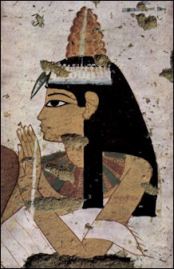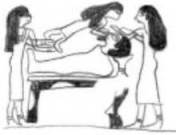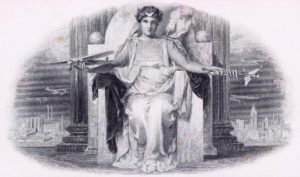
The charm of beautiful hair
We are not immune to the charms of a beautiful head of hair and the ancient Egyptians weren’t either.
But they took appreciation for hair, especially feminine hair, to a whole new level of magnitude. For them, hair was magical. And, of course, Who would have the most magical hair of all? The Goddess of Magic: Isis Herself.
I have always understood that the long hair of Isis in Egyptian tradition—disarrayed and covering Her face in mourning or falling in heavy, dark locks over Her shoulders—to be the predecessor of the famous Veil of Isis of later tradition. Ah, but there is so much more.
In ancient Egypt, it was a mourning custom for Egyptian women to dishevel their hair. They wore it long and unkempt, letting it fall across their tear-stained faces, blinding them in sympathy with the blindness first experienced by the dead. As the Ultimate Divine Mourner, this was particularly true of Isis. At Koptos, where Isis was notably worshipped as a Mourning Goddess, a healing prayer made “near the hair at Koptos” is recorded. Scholars consider this a reference to Mourning Isis with Her disheveled and powerfully magical hair.

Mourners use various mourning gestures and dishevel their hair
It is in Her disheveled, mourning state, that Isis finally finds Osiris. She reassembles Him, fans life into Him, and makes love with Him. As She mounts His prone form, Her long hair falls over Their faces, concealing Them like a veil and providing at least some perceived privacy for Their final lovemaking. As the Goddess and God make love, the meaning of Isis’ hair turns from death to life. It becomes sexy—remember those big-haired “paddle doll” fertility symbols?
This pairing of love and death is both natural and eternal. How many stories have you heard—or perhaps you have a personal one—about couples making love after a funeral? It’s so common that it’s cliché. But it makes perfect sense: in the face of death, we human beings must affirm life. We do so through the mutual pleasure of sex and, for heterosexual couples, the possibility of engendering new life that sex provides.

Isis, in kite form, covers and makes love with Osiris
The lovemaking of Isis and Osiris is the ultimate expression of this. Chapter 17 of the Book of Coming Forth by Day (aka the Book of the Dead), describes the disheveled hair of Isis when She comes to Osiris:
“I am Isis, you found me when I had my hair disordered over my face, and my crown was disheveled. I have conceived as Isis, I have procreated as Nephthys.” (Chapter 17; translation by Rosa Valdesogo Martín, who has extensively studied the connection of hair to funerary customs in ancient Egypt.)

A mourning woman with her hair over her face from the tomb of Minnakht
There is also a variant of this chapter that has Isis apparently straightening up Her “bed head” following lovemaking:
“Isis dispels my bothers (?) [The Allen translation has “Isis does away with my guard; Nephthys puts an end to my troubles.]. My crown is disheveled; Isis has been over her secret, she has stood up and has cleaned her hair.” (Chapter 17 variant, translation by Martín, above.)
This lovemaking of Goddess and God has cosmic implications for its result is a powerful and important new life: Horus. As the new pharaoh, Horus restores order to both kingdom and cosmos following the chaos brought on by the death of the old pharaoh, Osiris.
Not only is hair symbolic of the blindness of death and the new life of lovemaking; the hair of the Goddesses is actually part of the magic of rebirth. Isis and Her sister, Nephthys, are specifically called the Two Long Haired Ones. The long hair of the Goddesses is associated with the knotting, tying, wrapping, weaving, knitting, and general assembling necessary to bring about the great Mystery of rebirth. Hair-like threads of magic are woven about the deceased who has returned to the womb of the Great Mother. The Coffin Texts give the name of part of the sacred boat of the deceased (itself a symbolic womb) as the Braided Tress of Isis.

Mourners, probably Isis and Nephthys, throw Their hair over the Osiris
In some Egyptian iconography, we see mourning women, as well as the Goddesses Isis and Nephthys, with hair thrown forward in what is known as the nwn gesture. Sometimes they/They actually pull a lock of hair forward, especially toward the deceased, which is called the nwn mgesture. It may be that this gesture, especially when done by Goddesses, is meant to transfer new life to the deceased, just as Isis’ bed-head hair brought new life to Osiris. It is interesting to note that the Egyptians called vegetation “the hair of the earth” and that bare land was called “bald” land, which simply reiterates the idea of hair is an expression of life.
Spell 562 of the Coffin Texts notes the ability of the hair of Isis and Nephthys to unite things, saying that the hair of the Goddesses is knotted together and that the deceased has come to “be joined to the Two Sisters and be merged in the Two Sisters, for they will never die.”

Isis and Nephthys pull a lock of hair toward the deceased
The Pyramid Texts instruct the resurrected dead to loosen their bonds, “for they are not bonds, they are the tresses of Nephthys.” Thus the magical hair of the Goddesses is only an illusory bond. Their hair is not a bond of restraint but rather the bonding agent needed for rebirth. Like the placenta that contains and feeds the child but is no longer necessary when the child is born, the reborn one throws off the tresses of the Goddesses that had previously wrapped her or him in safety.
The Egyptian idea of Isis as the Long-Haired One carried over into Her later Roman cult, too. In Apuleius’ account of the Mysteries of Isis, he describes the Goddess as having long and beautiful hair. Her statues often show Her with long hair, and Her priestesses were known to wear their hair long in honor of their Goddess.

This is sketched from a coffin found in Gebelein (now Naga-el Gheria), 13th dynasty. Either a long-haired female image or a tiny long-haired female person is spreading her hair over the deceased. I must find a photo of this…it is freakin’ amazing!
This little bit of research has inspired me to want experiment with the magic of hair in ritual. In Isis Magic, the binding and unbinding of the hair is part of the “Lamentations of Isis” rite (where it is very powerful, I can tell you from experience), but I want to try using it in some solitary ritual, too. I have longish hair, so that will work, but if you don’t and are, like me, inspired to experiment, try using a veil. It is most certainly in Her tradition. (See “Veil” in my Offering to Isis.)
If you want to learn more about the traditions around hair and death, please visit Rosa Valdesogo Martín’s amazing and extensive site here. That’s where most of these images come from…many of which I had not seen before. Thank you, Rosa!
Medusa in Greek Mythology
compiled by Tracy Marks
http://www.windweaver.com/as/index.htm
Medusa, originally a beautiful young woman whose crowning glory was her magnificent long hair, was desired and courted by many suitors. Yet before she could be betrothed to a husband, Poseidon (Neptune) found her worshipping in the temple of Athena (Minerva) and ravished her. Athena was outraged at her sacred temple being violated, and punished Medusa by turning her beautiful tresses into snakes and giving her the destructive power to turn anyone who looked directly at her into stone.
In both Greek and Roman mythology, Perseus, attempting to rescue his mother Danae from the coercive King Polydectes, needed to embark on the dangerous venture of retrieving Medusa's head. With the help of Athena and Hermes - magic winged sandals, a cap, a pouch and a mirror-like shield, he fought her and beheaded her by viewing her image in the mirror of his shield rather than looking at her directly. From her decapitated head sprang the winged horse Pegasus and the giant Chrysaor, who became king of Iberia. Medusa's sisters, the Gorgons, chased after him, but were unable to catch him because his magic cap made him invisible.
Perseus was then able to use Medusa's head as a weapon during other battles (which included rescuing Andromeda), but he eventually returned it to Athena, who then placed it at the center of her Aegis as a symbol of her power, and her own capacity to turn her enemies into stone.
Historically, before ancient Greece, Medusa was worshipped by the Libyan Amazons as a Serpent -Goddess, and associated with the destroyer aspect Anath (also known as Athene) of the Triple Goddess in North Africa and Crete. The name Medusa (Medha in Sanscrit, Metis in Greek and Maat in Egyptian) means "sovereign female wisdom." This online Medusa paper discusses the Libyan and Near Eastern conceptions of Medusa.
Some scholars believe that the Greek and Roman Medusa myth, as told by Ovid, expresses the vanquishing of the great goddess religions as the male gods Zeus/Jupiter and Poseidon/Neptune gained power. Others view it as expressive of the subjugation of women's bodies and enslavement of their spirit by a violent and oppressive male-oriented culture, which viewed Medusa's life-giving, creative, primal energy as threatening.
Psychoanalytic interpretations of the Medusa myth focus upon Medusa's snake-like hair representing bleeding female genitals, and the frightening power of the wounded (perhaps "castrated"), devouring mother over the fragile male psyche. Seeking his own manhood, the son must conquer his early identification with his mother and his regressive tendency to submit to maternal power and be swallowed up again by the womb. In order to avoid being symbolically castrated himself, and to be capable of mature sexual relations with a woman, he must first "behead" the mother archetype. Only then is he free to express his own power as a man, to form an equal partnership with a woman, and to eventually be helper to his own mother.
In "For the Love Of Medusa" (Psychoanalytic Review, vol.62, no.1, 1975) Richard Geha wrote: "The murder of Medusa expresses the son's re-enactment of the crimes of the primal scene by chopping off the head representing the genitals of the once phallic mother. He exhibits the frightening power taken from a dead and castrated mother and redeems the endangered mother .... Perseus went to a lot of trouble to kill a woman and rob her of her terror. But was all necessary before he could look upon the nude and bejeweled body of a woman and carry off his own mother....Now she and her son can travel together where they will."
Apart from the Medusa story focused Poseidon's rape, other versions of Medusa legends exist. Consider this brief statement byApollonius: [1:161] "But it is alleged by some that Medusa was beheaded for Athena's sake; and they say that the Gorgon was fain to match herself with the goddess even in beauty." This same version is echoed by Bullfinch: "She was once a beautiful maiden whose hair was her chief glory but as she dared to vie in beauty with Minerva (Athena), the goddess deprived her of her charms and changed her beautiful ringlets into hissing serpents."
Finally, two very different pictures of Medusa and her fate were portrayed by Pausanian in his Description of Greece:
[2.21.5] "In the market-place of Argos is a mound of earth, in which they say lies the head of the Gorgon Medusa.... After the death of her father, Phorcus, she reigned over those living around Lake Tritonis, going out hunting and leading the Libyans to battle. On one such occasion, when she was encamped with an army over against the forces of Perseus, who was followed by picked troops from the Peloponnesus, she was assassinated by night. Perseus, admiring her beauty even in death, cut off her head and carried it to show the Greeks.
[2.21.6] But Procles, the son of Eucrates, a Carthaginian, thought a different account more plausible than the preceding. It is as follows. Among the incredible monsters to be found in the Libyan desert are wild men and wild women. Procles affirmed that he had seen a man from them who had been brought to Rome. So he guessed that a woman wandered from them, reached Lake Tritonis, and harried the neighbours until Perseus killed her; Athena was supposed to have helped him in this exploit, because the people who live around Lake Tritonis are sacred to her."
from Ovid, Metamorphoses
book 4:1181-95
from Thomas More translation
Beyond all others she
was famed for beauty, and the envious hope
of many suitors. Words would fail to tell
the glory of her hair, most wonderful
of all her charms--A friend declared to me
he saw its lovely splendour. Fame declares
the Sovereign of the Sea attained her love
in chaste Minerva's temple. While enraged
she turned her head away and held her shield
before her eyes. To punish that great crime
Minerva changed the Gorgon's splendid hair
to serpents horrible. And now to strike
her foes with fear, she wears upon her breast
those awful vipers--creatures of her rage.
from Dryden translation
Medusa once had charms; to gain her love
A rival crowd of envious lovers strove.
They, who have seen her, own, they ne'er did trace
More moving features in a sweeter face.
Yet above all, her length of hair, they own,
In golden ringlets wav'd, and graceful shone.
Her Neptune saw, and with such beauties fir'd,
Resolv'd to compass, what his soul desir'd.
In chaste Minerva's fane, he, lustful, stay'd,
And seiz'd, and rifled the young, blushing maid.
The bashful Goddess turn'd her eyes away,
Nor durst such bold impurity survey;
But on the ravish'd virgin vengeance takes,
Her shining hair is chang'd to hissing snakes.
These in her Aegis Pallas joys to bear,
The hissing snakes her foes more sure ensnare,
Than they did lovers once, when shining hair.
from Mandelbaum translation
Medusa was astonishingly fair;
she was desired and contended for -
so many jealous suitors hoped to win her.
Her form was graced by many splendors, yet
there was no other beauty she possessed
that cold surpass the splendor of her hair -
and this I learned from one who said he'd seen her.
Her beauty led the Ruler of the Sea
To rape her in Minerva's sanctuary
(so goes the tale). Jove's daughter turned aside
chaste eyes: the goddess hid her face behind
her aegis - but she made Medusa pay:
she changed that Gorgon's hair to horrid snakes.
And to this day, Minerva, to dismay
and terrify her foes, wears on her breast
the very snakes that she herself had set -
as punishment - upon Medusa's head.
from Humphries translation
She was a very lovely one, the hope of many
An envious suitor, and of all her beauties
Her hair most beautiful - at least I heard so
From one who claimed he had seen her. One day Neptune
Found her and raped her, in Minerva's temple,
And the goddess turned away, and hid her eyes
Behind her shield, and punishing the outrage
As it deserved, she changed her hair to serpents,
And even now, to frighten evil doers,
She carries on her breastplate metal vipers
To serve as awful warning of her vengeance.
from The Muse as Medusa
by May Sarton
FIRST STANZA
I saw you once, Medusa; we were alone.
I looked you straight in the cold eye, cold.
I was not punished, was not turned to stone -
How to believe the legends I am told?...
SEVENTH STANZA
I turn your face around! It is my face.
That frozen rage is what I must explore -
Oh secret, self-enclosed, and ravaged place!
This is the gift I thank Medusa for.
copyright 1978 from Invocations and Mythologies
in Collected Poems of May Sarton
Medusa and Perseus Links
Greek Myth Link Medusa
http://www.maicar.com/GML/Medusa1.html
*Paper on Medusa
http://www.perseus.tufts.edu/classes/finALp.html
The Gorgon Medusa
http://www.perseus.tufts.edu/cgi-bin/engindex?lookup=medusa
http://www.perseus.tufts.edu/cgi-bin/text?lookup=encyclopedia+medusa&word=medusa
Apollodorus: Perseus and Medusa
http://www.perseus.tufts.edu/cgi-bin/text?lookup=apollod.+2.4.3
Perseus page *
http://www.maicar.com/GML/Perseus1.html
Bullfinch Perseus
http://www.showgate.com/shownet/medea/bulfinch/bull15.html
Perseus and Medusa Images
http://www.perseus.tufts.edu/cgi-bin/image?arch=1993.01.0639&type=vase
http://www.perseus.tufts.edu/cgi-bin/image?arch=1991.09.0612&type=site
http://jblstatue.com/pages/medusa_gorgon.html
http://jblstatue.com/pictures/f_medusa_gorgon.jpg









